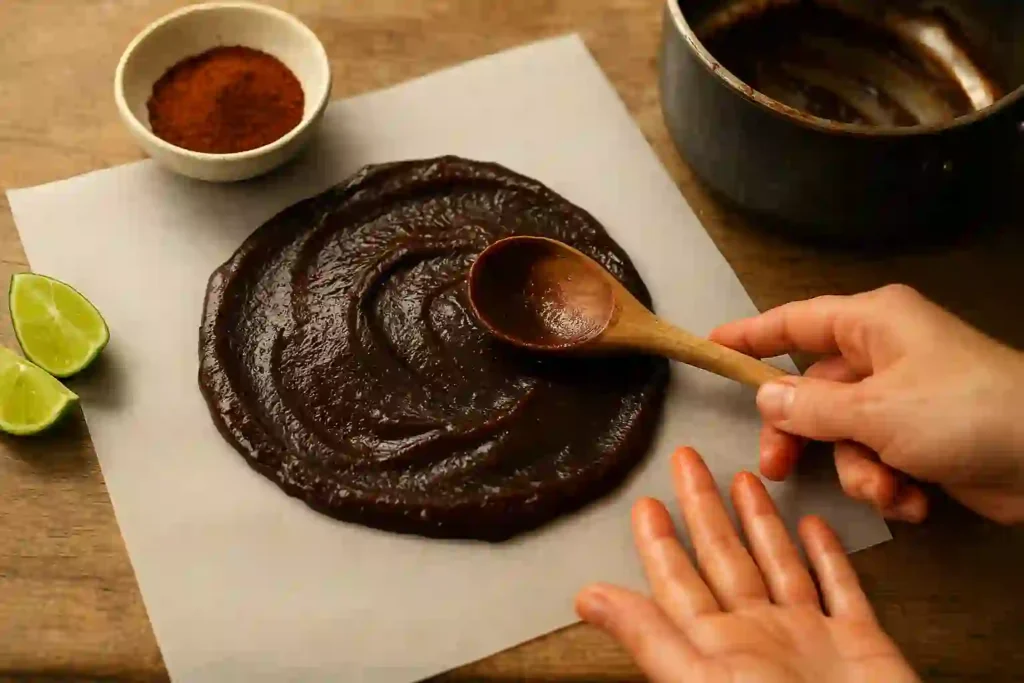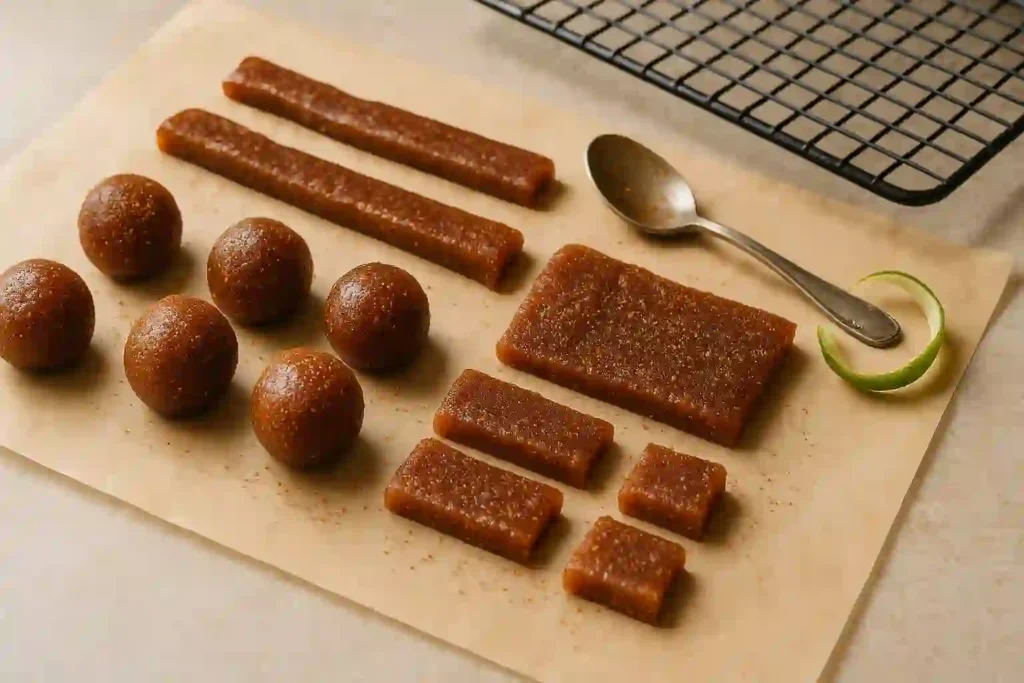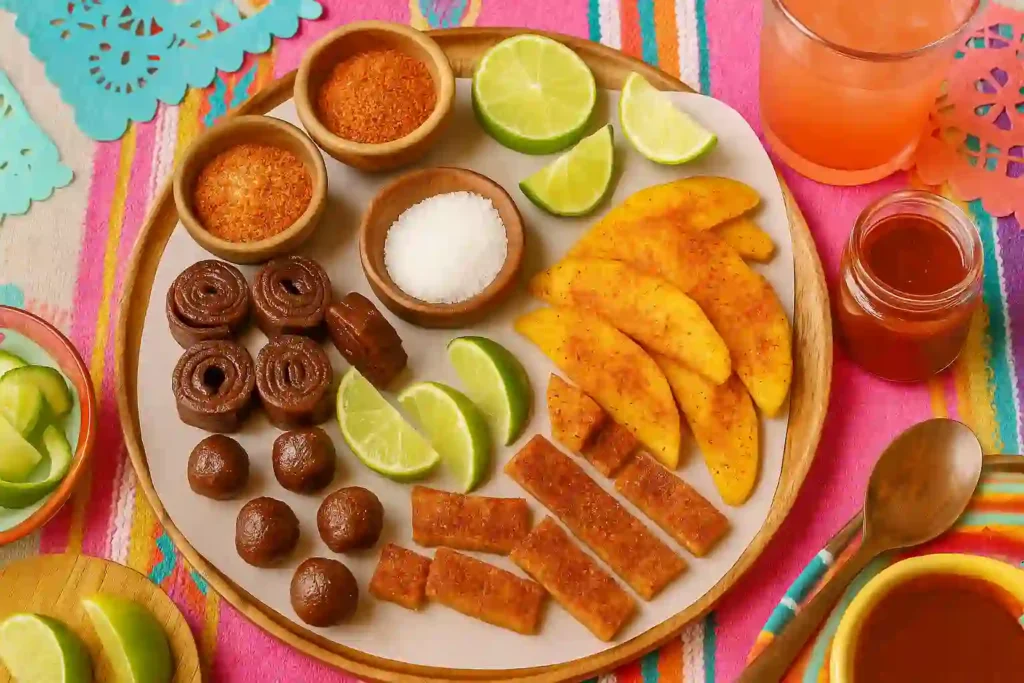Discover the Sweet & Spicy Charm of Mexican Candy
You don’t just eat mexican candy—you brace for it. That first bite? It’s chaos in the best way. Tart tamarind smacks your taste buds, chili heat flares up just enough to make you blink, and then—bam—a layer of fruity sweetness settles everything down. It’s like your mouth is trying to decode three languages at once, and somehow, it works.
Here’s the thing: most Americans grow up with peanut butter cups and sour worms. So when mexican candy started popping up in U.S. snack aisles and TikTok taste tests, it felt… foreign. A little intimidating. But also—let’s be honest—kind of irresistible. And now? It’s a full-on obsession. From Texas to Toronto, people are adding Tajín to watermelon slices and chasing spice with sugar.
I didn’t grow up eating this stuff. The first time I tried a Pulparindo, it was at a friend’s backyard party. I thought it was a fruit roll-up. Spoiler: it wasn’t. It was weird and wild—and I loved it. So much that I started experimenting with homemade versions. Not the exact same ones you’d find in a Dulcería in Mexico, sure, but close enough to bring the thrill home.
That’s what this recipe is about. A western-style take on mexican candy that’s punchy, playful, and made with ingredients you can actually find in a regular grocery store. If you’ve got a sweet tooth with a rebellious streak, you’re going to want to stick around.
What You’ll Need to Make Bold & Addictive Mexican Candy
Let’s be real—mexican candy isn’t shy. It doesn’t whisper; it shouts. Sweet, sour, spicy, salty… all in one bite. But here’s the good news: making a Western-style version at home doesn’t require exotic ingredients or a passport. You just need a handful of flavorful staples—and a bit of boldness.
Core Ingredients for Authentic Mexican Candy Flavor
- 1/2 cup tamarind paste
This is non-negotiable. Tamarind is what gives the candy that tangy, lip-puckering base. You’ll find it at international stores or even Amazon. Just make sure it’s seedless. - 2 tbsp chili powder (like Tajín or mild ancho chili)
Spice is the heartbeat here. Tajín is a go-to for that chili-lime magic, but you can play with the heat level. - 1/4 cup sugar
Balances out all that tartness. If you’re watching your sugar, feel free to scale it down or use coconut sugar—it’s got a lovely toasted flavor. - 2 tbsp light corn syrup or agave
Think texture. This helps everything bind together and stay chewy. Agave works if you want a cleaner label. - 2 tbsp fresh lime juice
Yes, it has to be fresh. Bottled lime just doesn’t bring the same brightness. - 1/2 tsp salt
Because a pinch of salt makes everything pop.
Optional Add-ins & Flavor Tweaks for Homemade Mexican Candy
- Mango or watermelon fruit powder (1 tbsp) – gives it that chamoy-like twist
- Dried chili flakes – for when you want an extra kick
- Maple syrup – works in a pinch if you’re out of corn syrup
- Monk fruit or erythritol – sugar-free alternatives that still play nice with flavor
Real Talk: Choosing the Good Stuff for Killer Mexican Candy
- Don’t buy tamarind that’s dry or grainy. Look for a rich, almost glossy paste.
- Your chili powder should smell bright and peppery, not dusty.
- And please—don’t skip the lime. It’s the thing that ties it all together.

FAQ – Is there a way to make it gluten-free?
Yep. The core ingredients are naturally gluten-free, but always double-check labels—especially on spice blends and syrups. Some brands sneak in thickeners you don’t want.
Making Mexican Candy – A Beautiful Mess of Sweet, Heat & Sticky Fun
Making mexican candy at home isn’t exactly a clean activity. But let’s be honest: if your kitchen still looks like a showroom when you’re done, did you even cook?
This process is less about perfection and more about feel. You’ll stir, guess, adjust, maybe curse a little—then end up with something ridiculously delicious.
Set Up for Mexican Candy Success
Before you even touch the stove, lay down parchment paper like you’re about to paint. Grab a small saucepan, a wooden spoon, and whatever you’re using to spread candy (spatula, butter knife, clean credit card—no judgment).
A quick note: Lightly oiling your tools or hands with something neutral like avocado oil? Total lifesaver.
Stirring the Magic Behind Mexican Candy
- In your saucepan, add the tamarind paste, sugar, chili powder, lime juice, and salt. Medium heat. Stir slowly at first—these flavors are stubborn strangers who need convincing to mingle.
- Once things start to look smooth-ish, pour in the corn syrup or agave. At this point, it’ll go from gritty to glossy—almost like caramel with a bad attitude. Keep stirring. Don’t walk away.
- As the mixture thickens, you’ll notice it begins to pull away from the pan’s sides—that’s your cue. You’ve hit the sweet spot. Time to kill the heat.
Shape and Spread Your Mexican Candy While It’s Hot
Quickly now—spread the hot mix onto your parchment. Think fudge meets fruit leather. Thin spreads = chewy, pliable bites. Thick ones = more of a chew-and-rip vibe. Go with your gut.
Then, let it cool for 15 to 20 minutes. Or cheat and throw it in the fridge. No shame.
Shape Your Mexican Candy Any Way You Like
Once it’s cooled enough to touch but still pliable, shape it however you want:
- Roll into tamarind balls like traditional Mexican vendors do.
- Slice into strips for snack-style nibbles.
- Use cookie cutters if you’re feeling Pinteresty.
The beauty? No two batches ever look alike.
Tiny Fixes & Honest Tips
- Too sticky to shape? Oily fingers solve everything.
- Too hard? You might’ve cooked it a bit long. Next time, shave 30 seconds off.
- Too soft? Let it cook a touch longer or try less syrup.
- Too spicy? Mix it into a smoothie bowl or fruit salad and pretend it was intentional.

FAQ – Can I reuse candy that got too firm?
Absolutely. Just toss it back in a warm pan with a splash of water or lime juice and give it a second chance. This recipe? It forgives.
How to Remix Mexican Candy Without Losing Its Soul
The thing about mexican candy is that it doesn’t ask to be liked—it dares you to handle it. You don’t nibble it with a cup of tea. You tear into it with sticky fingers and maybe a half-squint because you went a little heavy on the chili this time.
So when people ask, “Can I tweak the recipe?” the answer is: of course. That’s the only way this works. Mexican candy was never meant to be sterile or fixed. It’s messy, loud, made to be passed around in schoolyards, sold from carts at dusk, stuffed into piñatas, and sometimes—it just shows up in your purse after a party, and you’re not even sure how it got there.
Variations That Stay True, But Wander a Bit
- Guava-lime fusion: Drop a spoonful of guava paste into the mix—watch it melt and mellow the spice like a ballad in the middle of a mosh pit. Add lime zest if you’re feeling poetic.
- Smoked candy bar: Want drama? Stir in a splash of mezcal right before cooling. That smoky afterburn is like adding eyeliner to an already bold face.
- Fruit leather realness: Spread the mix thin. Sprinkle Tajín across the top like confetti. Let it dry just enough to peel. Suddenly, it’s less candy, more edible memory.
- Pulparindo-inspired slab: Press the mixture into a tray, slice into rugged rectangles, and dust with chili sugar. Wrap them in wax paper. They won’t last.
Dietary Swaps That Still Punch
- No refined sugar? Go monk fruit + yacon syrup. It’ll firm up faster and may taste slightly nutty. A compromise? Maybe. But not a deal-breaker.
- Vegan is easy: No animal products here unless you wander into weird syrup territory. Stick to agave, and you’re golden.
- Gluten concerns? They don’t belong in this candy anyway, but spice blends sometimes sneak in modified starches. Read the fine print.
How to Serve It Like You Meant To
- Fiesta board: Imagine a charcuterie setup—but for candy. Include tamarind rolls, dried mango, lime wedges, and a small dish of chili-salt. Serve with cold beers or agua fresca. You’re hosting now.
- Crunchy contrast: Mix crushed pepitas into the warm mix just before setting. Now you’ve got chewy heat with a snap. It’s like if joy had texture.
- Surprise topping: Chop bits of candy and toss over vanilla ice cream. That hot-cold-sour-sweet thing? You’ll start doing it on purpose.

FAQ – What if my variation totally flops?
Then you did it right. Mexican candy was never meant to be neat. If it gets too spicy, roll it into something new. If it falls apart, call it brittle. Either way, someone will still eat it—probably with their fingers.
Nutrition Breakdown – What’s Actually in Your Mexican Candy?
Look, it’s candy. No one’s pretending this is a superfood—but it’s also not a chemical sugar bomb from a vending machine. There’s real fruit, natural acid, and yes, a little heat to fire things up. So what does one bite give you, really?
Let’s break it down.
Per Piece (approx. 1 of 20 small servings):
- Calories: ~40 (depends how generous you are when slicing)
- Total Fat: Basically none
- Sodium: ~50 mg (mostly from salt and chili powder)
- Sugar: ~7 g (agave or syrup + a touch from tamarind)
- Carbs: About 9 g
- Protein: Let’s just say… it’s not a protein bar
- Fiber: A bit—around 0.5 g from tamarind and lime pulp
A Few Surprises in the Details
- Vitamin C: There’s a whisper of it from the lime—about 2% daily value.
- Iron: Tamarind’s got trace amounts. Maybe 3% of what you need daily.
- Potassium: Not huge, but it’s in there. Around 1% DV.
And the best part? You know what’s in it. You made it. No mystery ingredients, no preservatives you can’t pronounce, no weird dyes that stain your teeth for hours.
Heads Up: The Sticky Truth
If you’re cutting back on sugar or carbs, you can adapt this. But fair warning—it might not stick together quite the same way. Alternatives like monk fruit or erythritol don’t caramelize like the real deal. Still, it’s worth experimenting.
FAQ – Is this healthier than store-bought candy?
In a lot of ways, yes. It’s fresher, less processed, and customizable. But yeah—it’s still sugar-forward. So enjoy it like you would a homemade brownie: not every day, but when you do, make it count.
Troubleshooting Mexican Candy – Messed It Up? Here’s How to Save It
Even when a recipe is simple, things can go sideways. Sometimes the candy won’t firm up. Other times it’s too spicy or hard enough to chip a tooth. Don’t stress—these hiccups are easy to fix, and in most cases, the batch isn’t ruined. It just needs a little help.
Problem 1: It’s Way Too Sticky
What went wrong:
Most likely, the mixture didn’t cook long enough—or your kitchen’s just extra humid.
Quick fix:
Let it cool longer, or pop it in the fridge for a few minutes. For your next batch, simmer for an extra minute and oil your hands or tools to keep things from sticking.
Problem 2: It Turned Out Hard as a Rock
What happened:
The mix probably cooked too long or got too hot.
How to fix it:
Warm it gently in the oven or over steam, then knead in a splash of lime juice or water. Still too tough? Break it into pieces and use it as a spicy-sweet topping for fruit or desserts.
Problem 3: It’s Spicier Than Expected
Why it’s happening:
Chili powder varies a lot—some are mild, others bring serious heat.
What helps:
Balance things out with a little extra sugar or a drizzle of honey. Can’t mix it back in? Serve the candy with fruit like mango or pineapple to mellow it out naturally.
Problem 4: The Flavor’s Off
The likely cause:
Cheap tamarind or bottled lime juice can throw things off. So can low-quality chili blends.
Try this instead:
Use fresh lime juice, a smooth tamarind paste, and stick with chili blends like Tajín or ground ancho for better balance and brightness.
FAQ – What if my candy won’t set at all?
No problem. Reheat it gently and stir until it thickens slightly. If that doesn’t work, turn it into a chamoy-style drizzle over fruit—or swirl it into yogurt. It may not be “candy,” but it’s still delicious.
Your Mexican Candy Questions—Answered
Let’s be honest—making candy (even a simple version) raises a few “wait, what if…” moments. Below are the most common questions people ask when they try this recipe for the first time—and exactly what you need to know.
Can I make it ahead of time?
Yes, and you probably should.
Mexican candy actually tastes better once it’s had time to rest. Make it the day before, let it cool completely, and store it in an airtight container. The flavors deepen overnight—and the texture firms up just right.
How long does it last?
About 1 to 2 weeks at room temp.
Just make sure it’s stored in a sealed container and kept in a cool, dry spot. Humidity is its enemy. For longer storage, the fridge works too—just let it come to room temp before serving.
Can I freeze it?
Technically? Yes.
But it’s not ideal. Freezing can change the texture, making it grainy or overly sticky when thawed. It’s better to make smaller batches fresh.
What if I don’t have tamarind paste?
You’ll need to improvise.
Tamarind gives the candy its signature sour-sweet punch, but in a pinch, you can sub with a mix of lemon juice, pomegranate molasses, and a bit of apricot jam. It won’t be traditional—but it’ll be tasty.
Can I make it without chili?
Sure—but you’ll miss the point.
Still, if you want a tamer version (for kids or spice-shy friends), skip the chili and dial up the lime and fruit powder instead. It’ll still have that sweet-tart balance, just without the fire.
Ready to Make It Yours? Your Turn to Craft Some Candy Chaos
If you’ve made it this far, chances are you’re more than ready to give mexican candy a shot. And honestly? You should. It’s sweet, it’s fiery, it’s a little messy—and it absolutely breaks the mold of what candy “should” be.
The best part? You don’t have to get it perfect. This recipe forgives. It’s flexible. And it always surprises. Maybe your batch is a little spicier than planned. Maybe the texture’s off the first time. But once you find your rhythm, you’ll never want to go back to store-bought sweets again.
So here’s your nudge: make a batch. Taste, tweak, laugh at the mess, then roll up those little candy balls and share them. With friends. With kids. Or just with yourself on a Tuesday night when the craving hits.
If you try this recipe, I’d love to hear how it went.
Drop a comment below, share your flavor twist, or rate the recipe if it brought a little heat and happiness to your kitchen.
And hey—if this spicy-sweet experiment hit the spot, you might also enjoy:
Let’s keep exploring. Food’s more fun that way.
Tried it? Leave a comment below with your favorite twist on this spicy-sweet classic—or tag us @quickmorsels if you post your batch online. We feature our favorite reader creations weekly!

